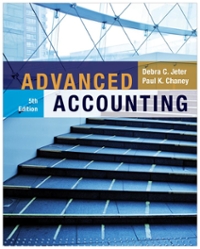Question
Journal EntriesandTrial Balance On October 1, 20Y6, Jay Pryor established an interior decorating business, Pioneer Designs. During the month, Jay completed the following transactions related
Journal EntriesandTrial Balance
On October 1, 20Y6, Jay Pryor established an interior decorating business, Pioneer Designs. During the month, Jay completed the following transactions related to the business:
Oct.1.Jay transferred cash from a personal bankaccountto an account to be used for the business, $27,600.4.Paid rent for period of October 4 to end of month, $2,680.10.Purchased a used truck for $23,000, paying $2,000 cash and giving a note payable for the remainder.13.Purchased equipment on account, $10,760.14.Purchased supplies for cash, $1,850.15.Paid annual premiums on property and casualty insurance, $4,140.15.Received cash for job completed, $11,590.
Enter the following transactions on Page 2 of the two-column journal:
21.Paid creditor a portion of the amount owed for equipment purchased on October 13, $3,840.24.Recorded jobs completed on account and sent invoices to customers, $13,190.26.Received an invoice for truck expenses, to be paid in November, $1,210.27.Paid utilities expense, $1,380.27.Paid miscellaneous expenses, $500.29.Received cash from customers on account, $5,520.30.Paid wages of employees, $3,670.31.Withdrew cash for personal use, $3,060.
Required:
1.Journalizeeach transaction in a two-columnjournalbeginning on Page 1, referring to the following chart of accounts in selecting theaccountsto be debited and credited. (Do not insert the account numbers in the journal at this time.) Journal entry explanations may be omitted. If an amount box does not require an entry, leave it blank.
11 Cash31 Jay Pryor, Capital12 Accounts Receivable32 Jay Pryor, Drawing13 Supplies41 Fees Earned14 Prepaid Insurance51 Wages Expense16 Equipment53 Rent Expense18 Truck54 Utilities Expense21 Notes Payable55 Truck Expense22 Accounts Payable59 Miscellaneous ExpenseGeneral JournalPage 1DateDescriptionPost. Ref.DebitCredit20Y6Oct. 1Cash
Jay Pryor, Capital
Oct. 4Rent Expense
Cash
Oct. 10Truck
Cash
Notes Payable
Oct. 13Equipment
Accounts Payable
Oct. 14Supplies
Cash
Oct. 15Prepaid Insurance
Cash
Oct. 15Cash
Fees Earned
General JournalPage 2DateDescriptionPost. Ref.DebitCredit20Y6Oct. 21Accounts Payable
Cash
Oct. 24Accounts Receivable
Fees Earned
Oct. 26Truck Expense
Accounts Payable
Oct. 27Utilities Expense
Cash
Oct. 27Miscellaneous Expense
Cash
Oct. 29Cash
Accounts Receivable
Oct. 30Wages Expense
Cash
Oct. 31Jay Pryor, Drawing
Cash
2.Post (in chronological order) the journal to aledgerof four-column accounts, inserting appropriatepostingreferences in the general journal as each item is posted. Extend the balances to the appropriate balance columns after each transaction is posted. If an amount box does not require an entry, leave it blank.
General LedgerAccountCashACCOUNT NO.11BalanceDateItemPost. Ref.DebitCreditDebitCredit20Y6Oct. 1Oct. 4Oct. 10Oct. 14Oct. 15Oct. 15Oct. 21Oct. 27Oct. 27Oct. 29Oct. 30Oct. 31
AccountAccounts ReceivableACCOUNT NO.12BalanceDateItemPost. Ref.DebitCreditDebitCredit20Y6Oct. 24Oct. 29
AccountSuppliesACCOUNT NO.13BalanceDateItemPost. Ref.DebitCreditDebitCredit20Y6Oct. 14
AccountPrepaid InsuranceACCOUNT NO.14BalanceDateItemPost. Ref.DebitCreditDebitCredit20Y6Oct. 15
AccountEquipmentACCOUNT NO.16BalanceDateItemPost. Ref.DebitCreditDebitCredit20Y6Oct. 13
AccountTruckACCOUNT NO.18BalanceDateItemPost. Ref.DebitCreditDebitCredit20Y6Oct. 10
AccountNotes PayableACCOUNT NO.21BalanceDateItemPost. Ref.DebitCreditDebitCredit20Y6Oct. 10
AccountAccounts PayableACCOUNT NO.22BalanceDateItemPost. Ref.DebitCreditDebitCredit20Y6Oct. 13Oct. 21Oct. 26
AccountJay Pryor, CapitalACCOUNT NO.31BalanceDateItemPost. Ref.DebitCreditDebitCredit20Y6Oct. 1
AccountJay Pryor, DrawingACCOUNT NO.32BalanceDateItemPost. Ref.DebitCreditDebitCredit20Y6Oct. 31
AccountFees EarnedACCOUNT NO.41BalanceDateItemPost. Ref.DebitCreditDebitCredit20Y6Oct. 15Oct. 24
AccountWages ExpenseACCOUNT NO.51BalanceDateItemPost. Ref.DebitCreditDebitCredit20Y6Oct. 30
AccountRent ExpenseACCOUNT NO.53BalanceDateItemPost. Ref.DebitCreditDebitCredit20Y6Oct. 4
AccountUtilities ExpenseACCOUNT NO.54BalanceDateItemPost. Ref.DebitCreditDebitCredit20Y6Oct. 27
AccountTruck ExpenseACCOUNT NO.55BalanceDateItemPost. Ref.DebitCreditDebitCredit20Y6Oct. 26
AccountMiscellaneous ExpenseACCOUNT NO.59BalanceDateItemPost. Ref.DebitCreditDebitCredit20Y6Oct. 27
Feedback
1. Identify which accounts are affected in each transaction. Keep in mind that every transaction involves at least two accounts. Determine whether the account increases or decreases and record each increase or decrease following the rules of debit and credit. Use the Posting Reference column to enter the corresponding account number from the general ledger account. Remember total debits should equal total credits in your entries.
2. See the illustration in Exhibit 5 in the text. The 4-column accounts ledger is a more formal presentation of the T accounts. The Posting Reference column should have the page number from the journal where the transaction is found. The debits and credits for each journal entry are posted to the accounts in the order in which they occur in the journal. After each entry, subtotal the 4-column ledger, making sure to maintain the correct normal balance and double-checking any non-normal balances to see if they are valid or possible.
3.Prepare anunadjusted trial balancefor Pioneer Designs as of October 31, 20Y6. For those boxes in which no entry is required, leave the box blank. The first two account titles are filled in as an example.
Pioneer Designs
Unadjusted Trial Balance
October 31, 20Y6Debit BalancesCredit BalancesCashAccounts Receivable
Jay Pryor, Drawing
Accounts Payable
Feedback
3. The trial balance is prepared from the ending balances of the ledger accounts. Be careful to put the debit balances in the Debit column and the credit balances in the Credit column. Remember the trial balance column totals should be equal.
4.Determine the excess ofrevenuesoverexpensesfor October.
$
5.Can you think of any reason why the amount determined in (4) might not be the net income for October?
- Fees earned includes some fees earned in the month of October that have not been received.
- Utilities expense includes expenses incurred for the month of October than have not yet been paid.
- Some supplies may have been used during October but no supplies expense has been recorded.
- Additions to capital has been wrongly recorded as drawings.
Feedback
Step by Step Solution
There are 3 Steps involved in it
Step: 1

Get Instant Access to Expert-Tailored Solutions
See step-by-step solutions with expert insights and AI powered tools for academic success
Step: 2

Step: 3

Ace Your Homework with AI
Get the answers you need in no time with our AI-driven, step-by-step assistance
Get Started


